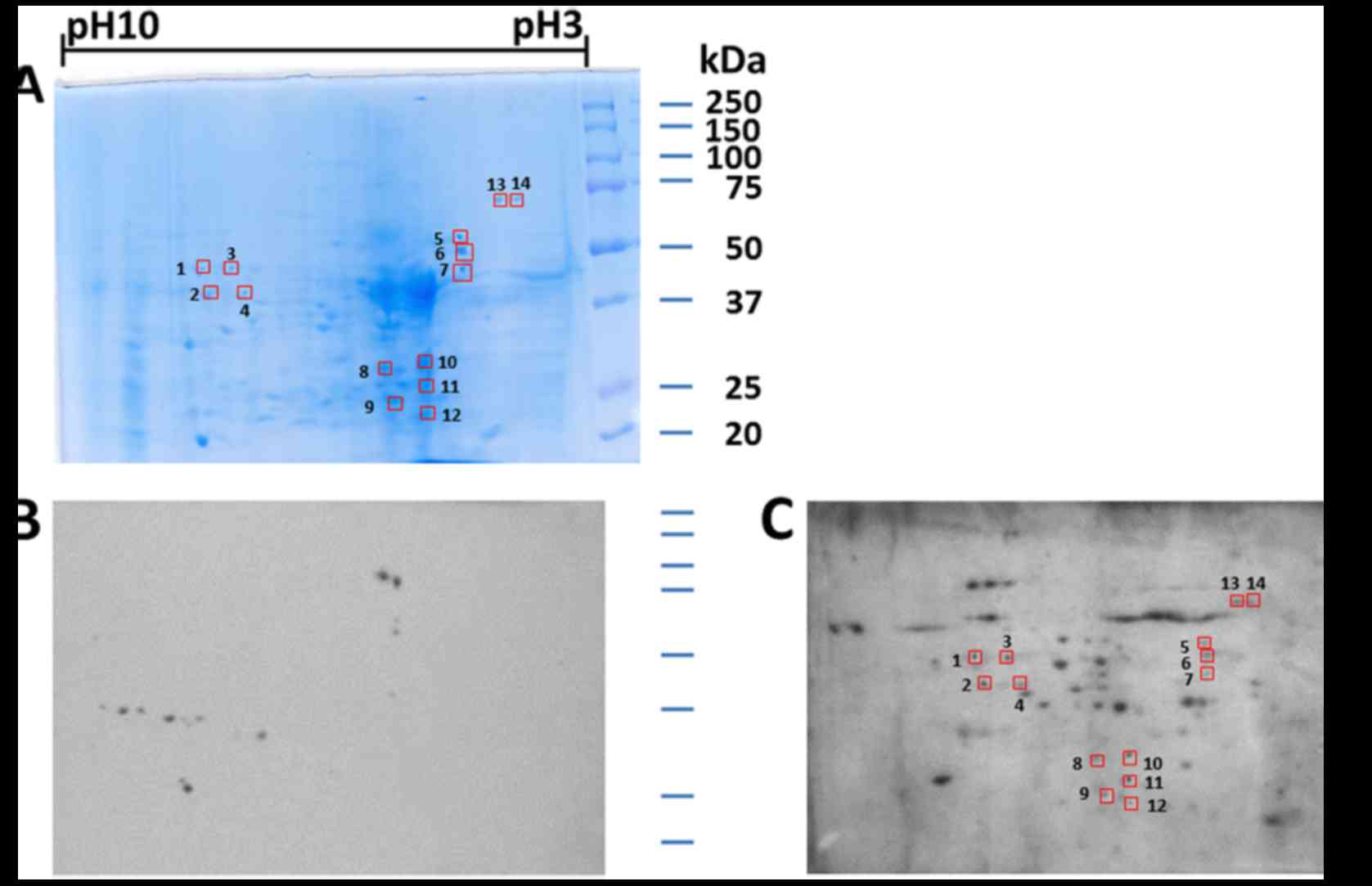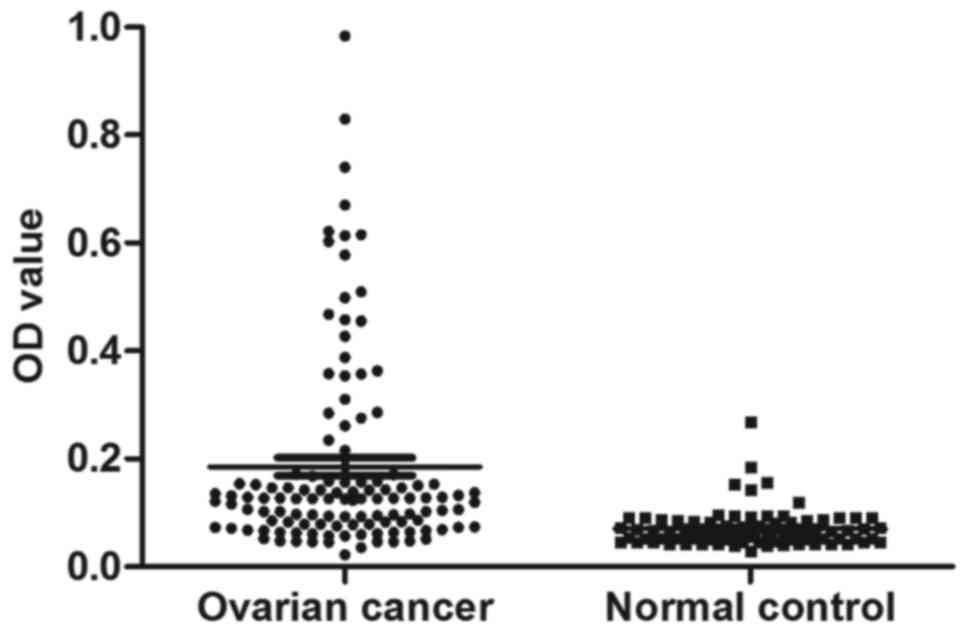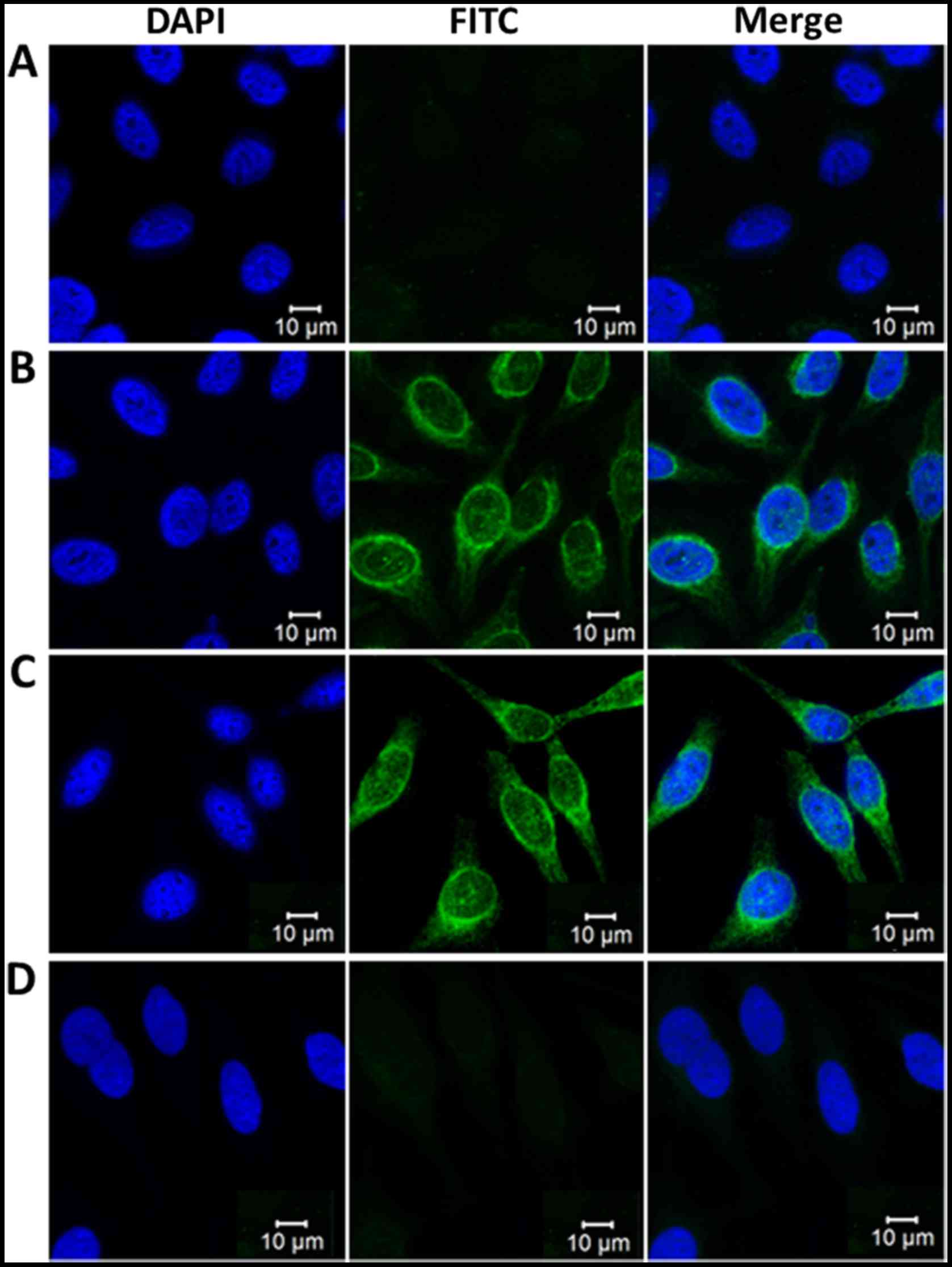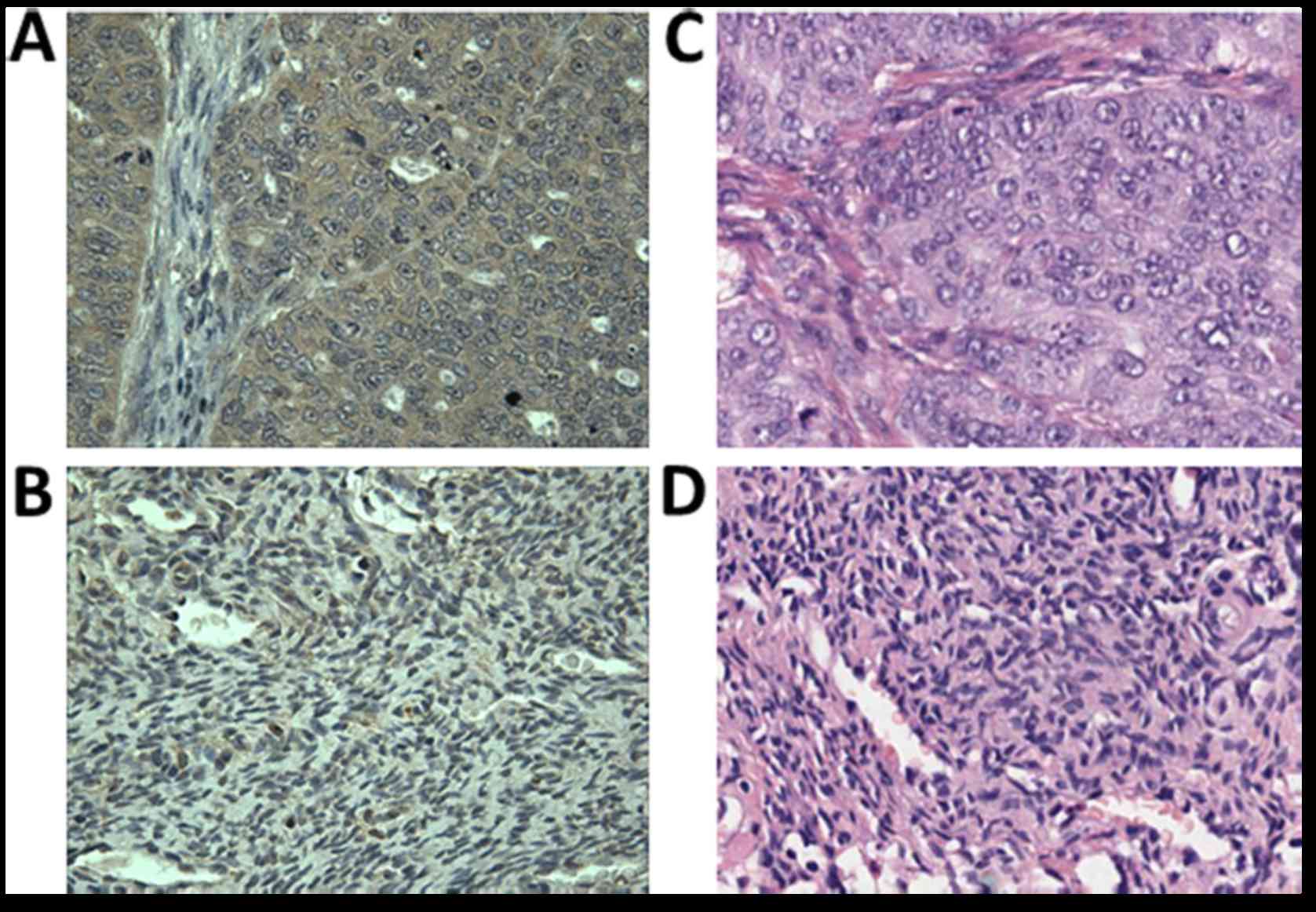Proteomic-based identification of HSP70 as a tumor-associated antigen in ovarian cancer
- Authors:
- Xin-Xin Liu
- Hua Ye
- Peng Wang
- Liu-Xia Li
- Yi Zhang
- Jian-Ying Zhang
-
Affiliations: Center for Tumor Biotherapy, The First Affiliated Hospital and College of Public Health, Zhengzhou University, Zhengzhou, Henan 450052, P.R. China - Published online on: March 24, 2017 https://doi.org/10.3892/or.2017.5525
- Pages: 2771-2778
This article is mentioned in:
Abstract
 |
 |
 |
 |
 |
|
Ferlay J, Shin HR, Bray F, Forman D, Mathers C and Parkin DM: Estimates of worldwide burden of cancer in 2008: GLOBOCAN 2008. Int J Cancer. 127:2893–2917. 2010. View Article : Google Scholar : PubMed/NCBI | |
|
Siegel R, Ma J, Zou Z and Jemal A: Cancer statistics, 2014. CA Cancer J Clin. 64:9–29. 2014. View Article : Google Scholar : PubMed/NCBI | |
|
Siegel R, Naishadham D and Jemal A: Cancer statistics, 2012. CA Cancer J Clin. 62:10–29. 2012. View Article : Google Scholar : PubMed/NCBI | |
|
Jayson GC, Kohn EC, Kitchener HC and Ledermann JA: Ovarian cancer. Lancet. 384:1376–1388. 2014. View Article : Google Scholar : PubMed/NCBI | |
|
Barua A, Bradaric MJ, Kebede T, Espionosa S, Edassery SL, Bitterman P, Rotmensch J and Luborsky JL: Anti-tumor and anti-ovarian autoantibodies in women with ovarian cancer. Am J Reprod Immunol. 57:243–249. 2007. View Article : Google Scholar : PubMed/NCBI | |
|
Naora H, Montz FJ, Chai CY and Roden RB: Aberrant expression of homeobox gene HOXA7 is associated with müllerian-like differentiation of epithelial ovarian tumors and the generation of a specific autologous antibody response. Proc Natl Acad Sci USA. 98:15209–15214. 2001. View Article : Google Scholar : PubMed/NCBI | |
|
Karabudak AA, Hafner J, Shetty V, Chen S, Secord AA, Morse MA and Philip R: Autoantibody biomarkers identified by proteomics methods distinguish ovarian cancer from non-ovarian cancer with various CA-125 levels. J Cancer Res Clin Oncol. 139:1757–1770. 2013. View Article : Google Scholar : PubMed/NCBI | |
|
Gagnon A, Kim JH, Schorge JO, Ye B, Liu B, Hasselblatt K, Welch WR, Bandera CA and Mok SC: Use of a combination of approaches to identify and validate relevant tumor-associated antigens and their corresponding autoantibodies in ovarian cancer patients. Clin Cancer Res. 14:764–771. 2008. View Article : Google Scholar : PubMed/NCBI | |
|
Santucci L, Bruschi M, Ghiggeri GM and Candiano G: The latest advancements in proteomic two-dimensional gel electrophoresis analysis applied to biological samples. Methods Mol Biol. 1243:103–125. 2015. View Article : Google Scholar : PubMed/NCBI | |
|
Lee JM and Kohn EC: Proteomics as a guiding tool for more effective personalized therapy. Ann Oncol. 21:(Suppl 7). vii205–vii210. 2010. View Article : Google Scholar : PubMed/NCBI | |
|
Hays JL, Kim G, Giuroiu I and Kohn EC: Proteomics and ovarian cancer: Integrating proteomics information into clinical care. J Proteomics. 73:1864–1872. 2010. View Article : Google Scholar : PubMed/NCBI | |
|
Looi KS, Nakayasu ES, Diaz RA, Tan EM, Almeida IC and Zhang JY: Using proteomic approach to identify tumor-associated antigens as markers in hepatocellular carcinoma. J Proteome Res. 7:4004–4012. 2008. View Article : Google Scholar : PubMed/NCBI | |
|
Opiteck GJ, Ramirez SM, Jorgenson JW and Moseley MA III: Comprehensive two-dimensional high-performance liquid chromatography for the isolation of overexpressed proteins and proteome mapping. Anal Biochem. 258:349–361. 1998. View Article : Google Scholar : PubMed/NCBI | |
|
Davidsson P, Westman A, Puchades M, Nilsson CL and Blennow K: Characterization of proteins from human cerebrospinal fluid by a combination of preparative two-dimensional liquid-phase electrophoresis and matrix-assisted laser desorption/ionization time-of-flight mass spectrometry. Anal Chem. 71:642–647. 1999. View Article : Google Scholar : PubMed/NCBI | |
|
Tragas C and Pawliszyn J: On-line coupling of high performance gel filtration chromatography with imaged capillary isoelectric focusing using a membrane interface. Electrophoresis. 21:227–237. 2000. View Article : Google Scholar : PubMed/NCBI | |
|
Tsugita A, Kawakami T, Uchida T, Sakai T, Kamo M, Matsui T, Watanabe Y, Morimasa T, Hosokawa K and Toda T: Proteome analysis of mouse brain: Two-dimensional electrophoresis profiles of tissue proteins during the course of aging. Electrophoresis. 21:1853–1871. 2000. View Article : Google Scholar : PubMed/NCBI | |
|
Langen H, Takács B, Evers S, Berndt P, Lahm HW, Wipf B, Gray C and Fountoulakis M: Two-dimensional map of the proteome of Haemophilus influenzae. Electrophoresis. 21:411–429. 2000. View Article : Google Scholar : PubMed/NCBI | |
|
Colvis CM, Duglas-Tabor Y, Werth KB, Vieira NE, Kowalak JA, Janjani A, Yergey AL and Garland DL: Tracking pathology with proteomics: Identification of in vivo degradation products of alphaB-crystallin. Electrophoresis. 21:2219–2227. 2000. View Article : Google Scholar : PubMed/NCBI | |
|
Jung E, Heller M, Sanchez JC and Hochstrasser DF: Proteomics meets cell biology: The establishment of subcellular proteomes. Electrophoresis. 21:3369–3377. 2000. View Article : Google Scholar : PubMed/NCBI | |
|
Brichory FM, Misek DE, Yim AM, Krause MC, Giordano TJ, Beer DG and Hanash SM: An immune response manifested by the common occurrence of annexins I and II autoantibodies and high circulating levels of IL-6 in lung cancer. Proc Natl Acad Sci USA. 98:9824–9829. 2001. View Article : Google Scholar : PubMed/NCBI | |
|
Brichory F, Beer D, Le Naour F, Giordano T and Hanash S: Proteomics-based identification of protein gene product 9.5 as a tumor antigen that induces a humoral immune response in lung cancer. Cancer Res. 61:7908–7912. 2001.PubMed/NCBI | |
|
Takashima M, Kuramitsu Y, Yokoyama Y, Iizuka N, Harada T, Fujimoto M, Sakaida I, Okita K, Oka M and Nakamura K: Proteomic analysis of autoantibodies in patients with hepatocellular carcinoma. Proteomics. 6:3894–3900. 2006. View Article : Google Scholar : PubMed/NCBI | |
|
Li L, Chen SH, Yu CH, Li YM and Wang SQ: Identification of hepatocellular-carcinoma-associated antigens and autoantibodies by serological proteome analysis combined with protein microarray. J Proteome Res. 7:611–620. 2008. View Article : Google Scholar : PubMed/NCBI | |
|
Fujita Y, Nakanishi T, Hiramatsu M, Mabuchi H, Miyamoto Y, Miyamoto A, Shimizu A and Tanigawa N: Proteomics-based approach identifying autoantibody against peroxiredoxin VI as a novel serum marker in esophageal squamous cell carcinoma. Clin Cancer Res. 12:6415–6420. 2006. View Article : Google Scholar : PubMed/NCBI | |
|
Fujita Y, Nakanishi T, Miyamoto Y, Hiramatsu M, Mabuchi H, Miyamoto A, Shimizu A, Takubo T and Tanigawa N: Proteomics- based identification of autoantibody against heat shock protein 70 as a diagnostic marker in esophageal squamous cell carcinoma. Cancer Lett. 263:280–290. 2008. View Article : Google Scholar : PubMed/NCBI | |
|
Zhang J, Wang K, Zhang J, Liu SS, Dai L and Zhang JY: Using proteomic approach to identify tumor-associated proteins as biomarkers in human esophageal squamous cell carcinoma. J Proteome Res. 10:2863–2872. 2011. View Article : Google Scholar : PubMed/NCBI | |
|
Peng B, Huang X, Nakayasu ES, Petersen JR, Qiu S, Almeida IC and Zhang JY: Using immunoproteomics to identify alpha-enolase as an autoantigen in liver fibrosis. J Proteome Res. 12:1789–1796. 2013. View Article : Google Scholar : PubMed/NCBI | |
|
Cappello P, Tomaino B, Chiarle R, Ceruti P, Novarino A, Castagnoli C, Migliorini P, Perconti G, Giallongo A, Milella M, et al: An integrated humoral and cellular response is elicited in pancreatic cancer by alpha-enolase, a novel pancreatic ductal adenocarcinoma-associated antigen. Int J Cancer. 125:639–648. 2009. View Article : Google Scholar : PubMed/NCBI | |
|
Bini L, Magi B, Marzocchi B, Arcuri F, Tripodi S, Cintorino M, Sanchez JC, Frutiger S, Hughes G, Pallini V, et al: Protein expression profiles in human breast ductal carcinoma and histologically normal tissue. Electrophoresis. 18:2832–2841. 1997. View Article : Google Scholar : PubMed/NCBI | |
|
Chen CN, Chang CC, Su TE, Hsu WM, Jeng YM, Ho MC, Hsieh FJ, Lee PH, Kuo ML, Lee H, et al: Identification of calreticulin as a prognosis marker and angiogenic regulator in human gastric cancer. Ann Surg Oncol. 16:524–533. 2009. View Article : Google Scholar : PubMed/NCBI | |
|
Du XL, Hu H, Lin DC, Xia SH, Shen XM, Zhang Y, Luo ML, Feng YB, Cai Y, Xu X, et al: Proteomic profiling of proteins dysregulted in Chinese esophageal squamous cell carcinoma. J Mol Med. 85:863–875. 2007. View Article : Google Scholar : PubMed/NCBI | |
|
Yom CK, Han W, Kim SW, Kim HS, Shin HC, Chang JN, Koo M, Noh DY and Moon BI: Clinical significance of annexin A1 expression in breast cancer. J Breast Cancer. 14:262–268. 2011. View Article : Google Scholar : PubMed/NCBI | |
|
Shen D, Nooraie F, Elshimali Y, Lonsberry V, He J, Bose S, Chia D, Seligson D, Chang HR and Goodglick L: Decreased expression of annexin A1 is correlated with breast cancer development and progression as determined by a tissue microarray analysis. Hum Pathol. 37:1583–1591. 2006. View Article : Google Scholar : PubMed/NCBI | |
|
Cheng TY, Wu MS, Lin JT, Lin MT, Shun CT, Huang HY, Hua KT and Kuo ML: Annexin A1 is associated with gastric cancer survival and promotes gastric cancer cell invasiveness through the formyl peptide receptor/extracellular signal-regulated kinase/integrin beta-1-binding protein 1 pathway. Cancer. 118:5757–5767. 2012. View Article : Google Scholar : PubMed/NCBI | |
|
Jorge YC, Mataruco MM, Araújo LP, Rossi AF, de Oliveira JG, Valsechi MC, Caetano A, Miyazaki K, Fazzio CS, Thomé JA, et al: Expression of annexin-A1 and galectin-1 anti-inflammatory proteins and mRNA in chronic gastritis and gastric cancer. Mediators Inflamm. 2013:1528602013. View Article : Google Scholar : PubMed/NCBI | |
|
Yu G, Wang J, Chen Y, Wang X, Pan J, Li Q and Xie K: Tissue microarray analysis reveals strong clinical evidence for a close association between loss of annexin A1 expression and nodal metastasis in gastric cancer. Clin Exp Metastasis. 25:695–702. 2008. View Article : Google Scholar : PubMed/NCBI | |
|
Wang KL, Wu TT, Resetkova E, Wang H, Correa AM, Hofstetter WL, Swisher SG, Ajani JA, Rashid A, Hamilton SR, et al: Expression of annexin A1 in esophageal and esophagogastric junction adenocarcinomas: Association with poor outcome. Clin Cancer Res. 12:4598–4604. 2006. View Article : Google Scholar : PubMed/NCBI | |
|
Hu N, Flaig MJ, Su H, Shou JZ, Roth MJ, Li WJ, Wang C, Goldstein AM, Li G, Emmert-Buck MR, et al: Comprehensive characterization of annexin I alterations in esophageal squamous cell carcinoma. Clin Cancer Res. 10:6013–6022. 2004. View Article : Google Scholar : PubMed/NCBI | |
|
Guo C, Liu S and Sun MZ: Potential role of Anxa1 in cancer. Future Oncol. 9:1773–1793. 2013. View Article : Google Scholar : PubMed/NCBI | |
|
Lam CY, Yip CW, Poon TC, Cheng CK, Ng EW, Wong NC, Cheung PF, Lai PB, Ng IO, Fan ST, et al: Identification and characterization of tropomyosin 3 associated with granulin-epithelin precursor in human hepatocellular carcinoma. PLoS One. 7:e403242012. View Article : Google Scholar : PubMed/NCBI | |
|
Tang HY, Beer LA, Tanyi JL, Zhang R, Liu Q and Speicher DW: Protein isoform-specific validation defines multiple chloride intracellular channel and tropomyosin isoforms as serological biomarkers of ovarian cancer. J Proteomics. 89:165–178. 2013. View Article : Google Scholar : PubMed/NCBI | |
|
Kinsella MD, Hinrichs B, Cohen C and Siddiqui MT: Highlighting nuclear membrane staining in thyroid neoplasms with emerin: Review and diagnostic utility. Diagn Cytopathol. 41:497–504. 2013. View Article : Google Scholar : PubMed/NCBI | |
|
Byrne JA, Tomasetto C, Garnier JM, Rouyer N, Mattei MG, Bellocq JP, Rio MC and Basset P: A screening method to identify genes commonly overexpressed in carcinomas and the identification of a novel complementary DNA sequence. Cancer Res. 55:2896–2903. 1995.PubMed/NCBI | |
|
Balleine RL, Fejzo MS, Sathasivam P, Basset P, Clarke CL and Byrne JA: The hD52 (TPD52) gene is a candidate target gene for events resulting in increased 8q21 copy number in human breast carcinoma. Genes Chromosomes Cancer. 29:48–57. 2000. View Article : Google Scholar : PubMed/NCBI | |
|
Wang R, Xu J, Saramäki O, Visakorpi T, Sutherland WM, Zhou J, Sen B, Lim SD, Mabjeesh N, Amin M, et al: PrLZ, a novel prostate-specific and androgen-responsive gene of the TPD52 family, amplified in chromosome 8q21.1 and overexpressed in human prostate cancer. Cancer Res. 64:1589–1594. 2004. View Article : Google Scholar : PubMed/NCBI | |
|
Rubin MA, Varambally S, Beroukhim R, Tomlins SA, Rhodes DR, Paris PL, Hofer MD, Storz-Schweizer M, Kuefer R, Fletcher JA, et al: Overexpression, amplification, and androgen regulation of TPD52 in prostate cancer. Cancer Res. 64:3814–3822. 2004. View Article : Google Scholar : PubMed/NCBI | |
|
Byrne JA, Balleine RL, Fejzo Schoenberg M, Mercieca J, Chiew YE, Livnat Y, St Heaps L, Peters GB, Byth K, Karlan BY, et al: Tumor protein D52 (TPD52) is overexpressed and a gene amplification target in ovarian cancer. Int J Cancer. 117:1049–1054. 2005. View Article : Google Scholar : PubMed/NCBI | |
|
Shukla S, Pranay A, D'Cruz AK, Chaturvedi P, Kane SV and Zingde SM: Immunoproteomics reveals that cancer of the tongue and the gingivobuccal complex exhibit differential autoantibody response. Cancer Biomark. 5:127–135. 2009. View Article : Google Scholar : PubMed/NCBI | |
|
Tong YQ, Zhang ZJ, Liu B, Huang J, Liu H, Liu Y, Guo FJ, Zhou GH, Xie PL, Li YH, et al: Autoantibodies as potential biomarkers for nasopharyngeal carcinoma. Proteomics. 8:3185–3193. 2008. View Article : Google Scholar : PubMed/NCBI | |
|
Cohen M, Dromard M and Petignat P: Heat shock proteins in ovarian cancer: A potential target for therapy. Gynecol Oncol. 119:164–166. 2010. View Article : Google Scholar : PubMed/NCBI | |
|
Tavaria M, Gabriele T, Kola I and Anderson RL: A hitchhiker's guide to the human Hsp70 family. Cell Stress Chaperones. 1:23–28. 1996. View Article : Google Scholar : PubMed/NCBI | |
|
Jäättelä M: Escaping cell death: Survival proteins in cancer. Exp Cell Res. 248:30–43. 1999. View Article : Google Scholar : PubMed/NCBI | |
|
Aghdassi A, Phillips P, Dudeja V, Dhaulakhandi D, Sharif R, Dawra R, Lerch MM and Saluja A: Heat shock protein 70 increases tumorigenicity and inhibits apoptosis in pancreatic adenocarcinoma. Cancer Res. 67:616–625. 2007. View Article : Google Scholar : PubMed/NCBI | |
|
Ralhan R and Kaur J: Differential expression of Mr 70,000 heat shock protein in normal, premalignant, and malignant human uterine cervix. Clin Cancer Res. 1:1217–1222. 1995.PubMed/NCBI | |
|
Lazaris AC, Theodoropoulos GE, Aroni K, Saetta A and Davaris PS: Immunohistochemical expression of C-myc oncogene, heat shock protein 70 and HLA-DR molecules in malignant cutaneous melanoma. Virchows Arch. 426:461–467. 1995. View Article : Google Scholar : PubMed/NCBI | |
|
Kaur J, Srivastava A and Ralhan R: Expression of 70-kDa heat shock protein in oral lesions: Marker of biological stress or pathogenicity. Oral Oncol. 34:496–501. 1998. View Article : Google Scholar : PubMed/NCBI | |
|
Alexiou D, Karayiannakis AJ, Syrigos KN, Zbar A, Sekara E, Michail P, Rosenberg T and Diamantis T: Clinical significance of serum levels of E-selectin, intercellular adhesion molecule-1, and vascular cell adhesion molecule-1 in gastric cancer patients. Am J Gastroenterol. 98:478–485. 2003. View Article : Google Scholar : PubMed/NCBI | |
|
Abe M, Manola JB, Oh WK, Parslow DL, George DJ, Austin CL and Kantoff PW: Plasma levels of heat shock protein 70 in patients with prostate cancer: A potential biomarker for prostate cancer. Clin Prostate Cancer. 3:49–53. 2004. View Article : Google Scholar : PubMed/NCBI | |
|
Chuma M, Sakamoto M, Yamazaki K, Ohta T, Ohki M, Asaka M and Hirohashi S: Expression profiling in multistage hepatocarcinogenesis: Identification of HSP70 as a molecular marker of early hepatocellular carcinoma. Hepatology. 37:198–207. 2003. View Article : Google Scholar : PubMed/NCBI | |
|
Nanbu K, Konishi I, Mandai M, Kuroda H, Hamid AA, Komatsu T and Mori T: Prognostic significance of heat shock proteins HSP70 and HSP90 in endometrial carcinomas. Cancer Detect Prev. 22:549–555. 1998. View Article : Google Scholar : PubMed/NCBI | |
|
Ciocca DR, Clark GM, Tandon AK, Fuqua SA, Welch WJ and McGuire WL: Heat shock protein hsp70 in patients with axillary lymph node-negative breast cancer: Prognostic implications. J Natl Cancer Inst. 85:570–574. 1993. View Article : Google Scholar : PubMed/NCBI | |
|
Thanner F, Sütterlin MW, Kapp M, Rieger L, Kristen P, Dietl J, Gassel AM and Müller T: Heat-shock protein 70 as a prognostic marker in node-negative breast cancer. Anticancer Res. 23:1057–1062. 2003.PubMed/NCBI | |
|
Thomas X, Campos L, Mounier C, Cornillon J, Flandrin P, Le QH, Piselli S and Guyotat D: Expression of heat-shock proteins is associated with major adverse prognostic factors in acute myeloid leukemia. Leuk Res. 29:1049–1058. 2005. View Article : Google Scholar : PubMed/NCBI | |
|
Sun XF, Zhang H, Carstensen J, Jansson A and Nordenskjöld B: Heat shock protein 72/73 in relation to cytoplasmic p53 expression and prognosis in colorectal adenocarcinomas. Int J Cancer. 74:600–604. 1997. View Article : Google Scholar : PubMed/NCBI |










